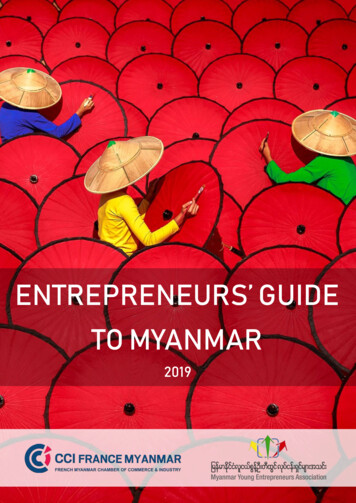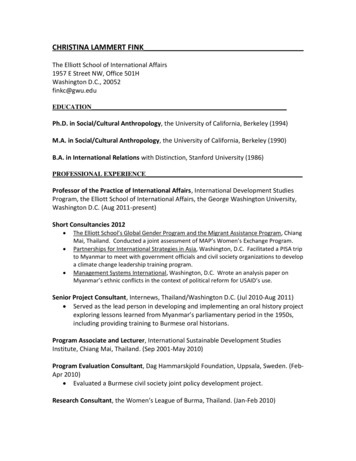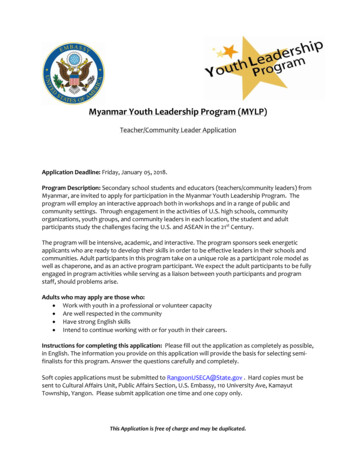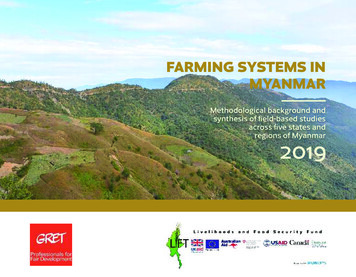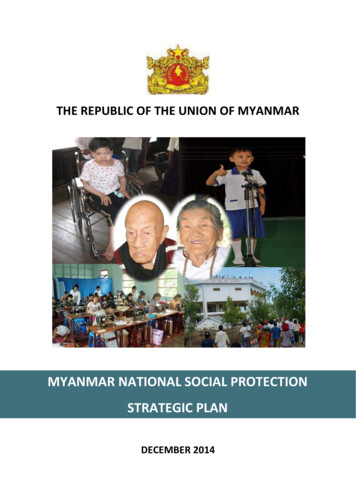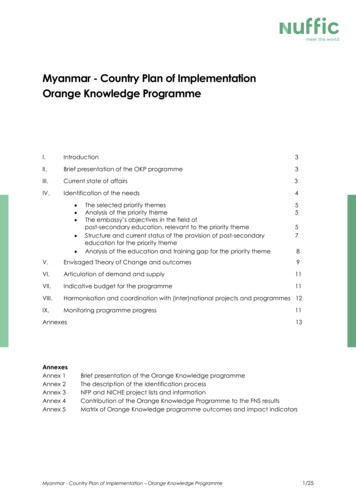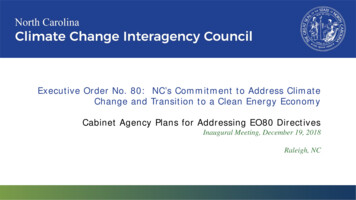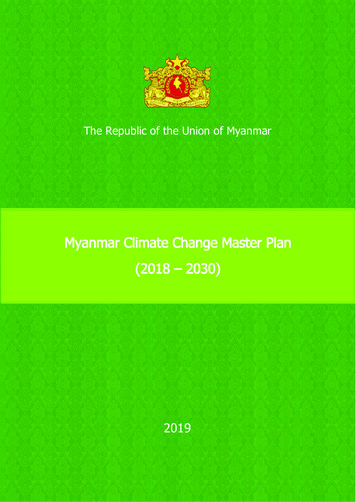
Transcription
The Republic of the Union of MyanmarMyanmar Climate Change Master Plan(2018 – 2030)2019
Myanmar Climate Change Master Plan (2018-2030)AcronymsADPCAsian Disaster Preparedness CenterAFAdaptation FundAgro-metAgricultural meterologyAIMsAgricultural Information Management SystemARIsAcademic and Research InstitutionsCBOsCommunity Based OrganizationsCDCsCity Development CommitteesCFUGCommunity Forestry User GroupCIFClimate Investment FundCo-opsCooperativesCSASClimate-smart Agriculture StrategyCSOsCivil Society OrganizationsCTCNClimate Technology Center and NetworkDARDepartment of Agricultural ResearchDFIDDepartment for International DevelopmentDMHDepartment of Meteorology and HydrologyDOADepartment of AgricultureDPsDevelopment PartnersDRDDepartment of Rural DevelopmentDRIDepartment of Research and InnovationDRRDisaster Risk ReductionDRR-WGDisaster Risk Reduction Working GroupDZGDDry Zone Greening DepartmentPage1
Myanmar Climate Change Master Plan (2018-2030)ECDEnvironmental Conservation DepartmentEIAEnvironmental Impact AssessmentEMFEnvironmental Management FundEUEuropean UnionFAOFood and Agriculture OrganizationFDForest DepartmentGADGeneral Adminstration DepartmentGCFGreen Climate FundGDPGross Domestic ProductGEFGlobal Environment FacilityGHGsGreenhouse GasesGISGeographic Information Systemhydro-metHydrological MeterologyIAsInternational AssociationsICTInformation and Communications TechnologyIEEInitial Environmental ExaminationIFIsInternational Financial InstitutionsIIEDInternational Institute for Environment and DevelopmentINDCIntended Nationally Determined ContributionINGOInternational Non-government OrganizationIPCCIntergovernmental Panel on Climate ChangeIWUMDIrrigation and Water Utilization Management DepartmentJICAJapan International Cooperation AgencyLDCFLeast Developed Country FundLGLocal GovernmentPage2
Myanmar Climate Change Master Plan (2018-2030)MCCAMyanmar Climate Change AllianceMCCSMyanmar Climate Change StrategyMCDCMandalay City Development CommitteeMERNMyanmar Environment Rehabilitation NetworkMESMyanmar Engineering SocietyMOALIMinistry of Agriculture, Livestock and IrrigationMOCMinistry of ConstructionMOEMinistry of EducationMOEEMinistry of Electricity and EnergyMOHAMinistry of Home AffairsMOHSMinistry of Health and SportsMOHTMinistry of Hotels and TourismMOIMinistry of IndustryMOINMinistry of InformationMONRECMinistry of Natural Resources and Environmental ConservationMOPFMinistry of Planning and FinanceMOSWRRMinistry of Social Welfare, Relief and ResettlementMOTCMinistry of Transportation and CommunicationNAPNational Adaptation PlanNDMCNational Disaster Management CommitteeNECCCCCNational Environmental Conservation and Climate Change CentralCommitteeNEMCNational Electricity Management CommitteeNEPNational Environmental PolicyNGOsNon-governmental organisationsNORADNorwegian Agency for Development CooperationPage3
Myanmar Climate Change Master Plan (2018-2030)NPTDCNay Pyi Taw Development CommitteeNWMCNational Water Management CommitteePPPPublic Private PartnershipPSPrivate SectorPSCProgramme Steering CommitteeREDD, REDD Reducing Emissions from Deforestation and Forest DegradationRIMESRegional Integrated Multi-Hazards Early Warning System for Africa and AsiaRRDRescue and Rehabilitation DepartmentSAPStrategic Action PlanSCCFSpecial Climate Change FundSEAStrategic Environmental AssessmentSIASocial Impact AssessmentSWMSoil and Water ManagementTWGTechnical Working GroupUMFCCIUnion of Myanmar Federation of Chambers of Commerce and IndustryUNUnited NationsUNDPUnited Nations Development ProgrammeUNEPUnited Nations Environment Programme (UN Environment)UNFCCCUnited Nations Framework Convention on Climate ChangeUN-HabitatUnited Nations Human Settlements ProgrammeUNICEFUnited Nations International Children's Emergency FundUNIDOUnited Nations Indrustrial Development OrganizationYCDCYangon City Development CommitteePage4
Myanmar Climate Change Master Plan (2018-2030)ForewordMyanmar aims to achieve a healthy and happy society that is able to resistchanges in climate regimes and whose economic development will be implementedthrough integrated low carbon approaches by 2030. The Myanmar Climate ChangeMaster Plan (2018-2030) has been formulated and adopted with the view towardmainstreaming a series of prioritized sectoral short, medium and long term actionsidentified in the Myanmar Climate Change Policy and Strategy.The Myanmar Climate Change Master Plan (2018-2030) showcases the result ofextensive in-depth sectoral consultations and bilateral discussions by line ministerialdepartments and enterprises, city development committees, research and academia,private and non-governmental organizations, civil-society organizations, developmentpartners from national and international agencies, experts, technical working groupsof Myanmar Climate Change Alliance (MCCA) as well as comments from relevant subnational stakeholders.The Myanmar Climate Change Master Plan (2018-2030) clearly defines a seriesof high-priority activities, their respective strategic indicators, and the responsibilitiesof involved stakeholders across six specific sectors prioritized in Myanmar ClimateChange Strategy defined as: “climate-smart agriculture, fisheries and livestock for foodsecurity, sustainable management of natural resources for healthy ecosystems,resilient and low-carbon energy, transport and industrial systems for sustainablegrowth, building resilient, inclusive and sustainable cities and towns in Myanmar,managing climate risks for people’s health and well-being, and building a resilientMyanmar society through education, science and technology”.The Environmental Conservation Department (ECD) has great confidence thatthis master plan will provide a guiding roadmap for proactive sectoral preparedness intailoring and scaling down the responses needed to address annual climate-inducednatural disasters facing with Myanmar as well as stimulating opportunities for longterm economic development along low carbon pathways. In addition, this Master Planserves as an operationalizing framework for ensuring Myanmar’s achievement of itsNationally Determined Contributions (NDC) to the 2015 Global Climate Change ParisAgreement.Page5
Myanmar Climate Change Master Plan (2018-2030)As a national cross-sectoral framework, ECD strongly urges all ministerial andsub-national governments, and investments from private and public organizations toincorporate the Myanmar Climate Change Master Plan (2018-2030) objectives andtargets, and necessary budgetary allocations within their respective short and longterm development plans, aligning with the specific targets set for 2020, 2025 and 2030.In addition, ECD strongly encourages private sector and development partners tosupport the government through develop its capacity in terms of technology, financeand human resources.ECD would like to express its gratitude to the many departments, technicalworking groups, experts from national and international organizations, vatecitizenswhohavecontributions to the formulation of this guiding framework, the Myanmar ClimateChange Master Plan (2018-2030).U Hla Maung TheinDirector GeneralEnvironmental Conservation DepartmentMinistry of Natural Resources and Environmental ConservationPage6
Myanmar Climate Change Master Plan (2018-2030)Table of contentsAcronyms1Foreword5Table of contents7Introduction: how to use the master plan10Master Plan’s design101. Climate-smart agriculture, fisheries, livestock for food security141.1 Sectoral outcome141.2 Expected results and indicators141.3 Objectives for action areas151.4 Actors151.5 Master plan 1: Climate-resilient agricultural productivity is achieved tosupport food security, livelihood strategies, GDP growth andgreenhouse gas reductions182. Sustainable management of natural resources for healthy eco-systems312.1 Sectoral outcome312.2 Expected results and indicators312.3 Objectives for action areas322.4 Actors322.5 Master plan 2: Management of natural resources for healthy ecosystems343. Resilient and low-carbon energy transport and industrial systems forsustainable growth453.1 Sectoral outcome453.2 Expected results and indicators453.3 Objectives for action areas463.4 Actors463.5 Master plan 3: Resilient and low-carbon energy, transport and industrialsystems for sustainable growth48Page7
Myanmar Climate Change Master Plan (2018-2030)4. Resilient, inclusive and sustainable cities and towns where people can liveand thrive564.1 Sectoral outcome564.2 Expected results and indicators564.3 Objectives for action areas574.4 Actors574.5 Master plan 4: Climate-resilient, inclusive and sustainable towns and citieswhere people can live and thrive5. Climate risk management for people’s health and wellbeing59695.1 Sectoral outcome695.2 Expected results and indicators695.3 Objectives for action areas705.4 Actors705.5 Master Plan 5: Climate risk management for people’s healthand wellbeing6. Education, science and technology for a resilient society72826.1 Sectoral outcome826.2 Expected results and indicators826.3 Objectives for action836.4 Actors846.5 Master plan 6: Education, science and technology for a resilient society86Annex I: Detailed strategy formulation process931. Description of the process942. Guiding principles of MCCS formulation953. Methodology and process97Phase 1. Defining the objectives and scope of the MCCS97Phase 2. Data collection, thematic consultations and sub-nationalworkshops100Phase 3. Initial validation and improvement, first draft of strategy104Page8
Myanmar Climate Change Master Plan (2018-2030)Phase 4. Additional information gathering and validation of theadvanced draft105Phase 5. Finalisation and dissemination of the MCCS107List of FiguresFigure 1: The five phases of the MCCS formulation process97Figure 2: Five clusters formed out of 19 townships suggested at the InitiationWorkshop in December 201499Figure 3: First national workshop for MCCS formulation,April 2015 in Nay Pyi Taw100Figure 4: Participants of the local consultations in Thandwe, October 2015104Figure5: Second national workshop, Nay Pyi Taw, 2 November 2015105Page9
Myanmar Climate Change Master Plan (2018-2030)Introduction: how to use the master planThis part contains the master plan (MP) for the MCCS (2018–2030), to be implementedby partners in each of Myanmar's six key sectoral areas:1. Agriculture, fisheries and livestock2. Environment and natural resources3. Energy, transport and industry4. Cities, towns and human settlements5. Climate hazards and health6. Education, science and technologyEach sectoral area has a designated focal agency that will monitor progress againstthe master plan.The master plan was formulated through over a year-long process of stakeholderconsultations — from April 2015 to August 2016 — with representatives from severalsectors, brought together under the Technical Working Group (TWG) of the MyanmarClimate Change Alliance Programme (MCCA). The result of these intense exchanges isa series of activities for each area of action, which we set out in this part. Although nota comprehensive list of all the actions possible in these broad sectors, they representkey entry points, with tangible and measurable outputs, that will contribute toachieving the MCCS’s overall goal: ‘By 2030, Myanmar has achieved climate-resilienceand pursued a low-carbon growth pathway to support inclusive and sustainabledevelopment’ in line with the national vision of the MCCS, which is to ‘transformMyanmar into a climate-resilient and carbon-efficient nation that is capable ofharnessing the benefits of low-carbon, resilient development for present and futuregenerations in a sustainable and inclusive manner’.Master Plan’s designThe master plan’s design includes: an overall outcome and expected results for thesector; strategic indicators; objectives for areas of action; activities for theseobjectives; outputs for the activities; indicators for each action; and timeframes andresponsibilities. In this section, we provide an overview of each of these components.Page10
Myanmar Climate Change Master Plan (2018-2030)1. Sectoral outcomes: These are concise descriptions of what the sector will resembleafter the successful implementation of the master plan. The six sectoral outcomes are:(a) Climate-resilient productivity and climate-smart responses in theagriculture, fisheries and livestock sectors to support food security andlivelihood strategies while also promoting resource-efficient and lowcarbon practices(b) Natural resource management that enhances the resilience of biodiversityand ecosystem services that support social and economic developmentand deliver carbon sequestration(c) Climate-resilient and low-carbon energy, transport and industrial systemsthat support inclusive and sustainable development and economic growth(d) All township and city dwellers, including the most vulnerable, are safe fromincreased risks of rapid- and slow-onset natural disasters and live insustainable, inclusive, low-carbon, climate-resilient towns(e) Communities and economic sectors are able to respond to and recoverfrom climate-induced disasters, risks and health impacts and build ahealthy society, and(f) Strengthened education, awareness and technological systems that foster aclimate-responsive society and human capital to design and implementclimate-resilient and low-carbon development solutions for inclusive andsustainable developmentAchieving all these sectoral outcomes will help Myanmar achieve the MCCS's mainobjectives and reach its overall goal of achieving climate-resilience and pursued alow-carbon growth pathway to support inclusive and sustainable development by2030.2. Sectoral expected results: These are the key minimal and tangible achievementseach sector must attain to achieve the sectoral outcome. They are the building blocksthat drive sectoral action.Page11
Myanmar Climate Change Master Plan (2018-2030)3. Strategic indicators: An indication of the type of processes, laws, policies andactivities that must be set up in order to monitor change. Indicators do not includenumeric baselines for now, although the strategy's implementation mechanism maydecide to improve them.4. Objectives for areas of action: These are six areas for action that activities thatstakeholders have agreed to focus on during the consultations. They are the objectiveseach sector aims to attain and activities under each master plan fall under one of thesix areas of action (policy, institutions, finance, capacity and technology, awareness,partnerships).For example, Objective for action area 1: "To integrate climate change in environmentand natural resource management policies, plans, research and development, andextension services at national, sectoral and local levels.”5. Activities for these objectives: These are all the activities, as agreed by stakeholdersduring the consultations, that will contribute to achieving the objectives under eacharea of action. They range from ongoing projects and sectoral activities that need tobe continued and strengthened, to new projects that need to be initiated.6. Outputs for the activities: Each activity has one or more output that can be achievedwithin the duration of the strategy. Delivering these outputs will contribute toachieving the expected sectoral results.7. Indicators: These are both quantitative and qualitative, and show stakeholderswhich signs to observe to monitor progress. Target values and baselines for theseindicators are not presented at this stage; but rather provide an indication of how tomonitor progress that the implementation mechanism can improve as required.8. Timeframe: This is divided in three segments: activities taking place within 3, 8 and13 years, corresponding to the short, medium and long term. Sectors need to reporton or record their activities within these segments. So, for example, activities that canbe initiated and achieved in two years fall within the short-term segment while thosethat will achieve outputs in six years fall under the medium-term. Activities that canbe completed only in the long-term fall under the 13-year segment. Some activities -Page12
Myanmar Climate Change Master Plan (2018-2030)such as awareness - will fall under all three segments, as we expect that, althoughtangible outputs can appear in the short term, they will require continuation overtime.9. Responsibility: This sets out roles and responsibilities for leading, driving, reportingon and participating in the actions and activities. An ambitious strategy like the MCCScannot be achieved without the participation of many different actors.10. Actors and reporting: Each sector has an overall focal agency that reports to thesecretariat on overall progress towards each sectoral outcome. For ease of monitoringand reporting, the MCCS reports on progress towards sectoral expected results only.There is a lead for each action and activity. The focal agencies are responsible forregularly reporting progress towards sectoral outcomes by consulting the differentleads.Page13
Myanmar Climate Change Master Plan (2018-2030)1.Climate-smart agriculture, fisheries, livestock for foodsecurity1.1Sectoral outcomeClimate-resilient productivity and climate-smart responses in the agriculture, fisheriesand livestock sectors to support food security and livelihood strategies while alsopromoting resource-efficient and low-carbon practices.1.2Expected results and indicatorsSectoral expected resultsStrategic indicatorsThe agriculture, fisheries and# of sectoral polices, plans, research and developmentlivestock sectors have integratedstrategy and extension services that integrate climateclimate change into their relevantchange and are practiced at national, sub-nationalpolicies, planning and budgetingand local levels;procedures and have put these into# of officials trained on sector-specific guidelines andpractice, taking into account gendertools for integrating climate change into planning andconsiderations.The agriculture, fisheries andlivestock sectors have adoptedbudgeting systems;# of sectors, geographical areas, and technologyspecific institutional arrangements, including a multistakeholder engagement framework developed toclimate-resilient andimplement climate change responses at national, sub-environmentally sound adaptationnational and local levels;technologies and climate-smart# of climate change adaptation projects implementedmanagement practices, supportedby international and domesticfinance.Institutional coordination and multistakeholder engagement frameworkhave been established and supportthe implementation of climatesmart responses in the agricultural,fisheries and livestock sectors,Page14through externally supported finance and domesticresources;# of climate-smart technologies and good practicesintroduced and scaled up in Central Dry Zone, theAyeyarwady Delta and Coastal Zone and lowlandareas;# of farmers (both men and women) benefiting fromthe introduction of climate-smart technologies andother responses;# of multi-stakeholder partnerships that supported the
Myanmar Climate Change Master Plan (2018-2030)including innovative businessscaling up of climate-resilient and low-carbonmodels and gender-sensitiveresponses.approaches.1.3Objectives for action areas1. Integrate climate change into agriculture, fishery and livestock policies, plans,research and development, and extension services at national, sectoral and locallevels.2. Establish and reinforce institutional arrangements to plan and implement climatechange responses.3. Establish financial mechanisms to mobilize and allocate resources for climatechange response and climate-responsive development.4. Increase access to climate-resilient and low-carbon technologies and practices.5. Enhance awareness and capacity to promote and implement climate-resilient andlow-carbon responses.6. Promote multi-stakeholder partnerships to support and scale up climate-resilientand low-carbon responses.1.4ActorsLead actor:Ministry of Agriculture, Livestock, and Irrigation (MOALI), including the followingdepartments: Department of Agriculture (DOA), Department of Agricultural Research (DAR), Department of Rural Development; Department of Planning; Department of Agriculture Land Management and Statistics ; Agriculture Mechanization Department, Irrigation and Water Utilization Management Department, andPage15
Myanmar Climate Change Master Plan (2018-2030) Livestock Breeding and Veterinary Department; Department of Fisheries; andDepartment of PlanningOther actors: Academic and research institutions (ARIs) — such as agricultural and forestryuniversities Ministry of Natural Resource and Environment Conservation (MONREC),Environmental Conservation Department (ECD) Regional and state government for addressing local priorities Ministry of Planning and Finance (MOPF) Ministry of Transport and Communication (MOTC), Department of Meteorologyand Hydrology (DMH) Ministry of Health and Sports (MOHS) Ministry of Industry (MOI) Ministry of Education (MOE) Ministry of Construction (MOC) Ministry of Social Welfare, Relief and Resettlement (MOSWRR) Local government at regional, district and township levels Development partners (DPs), including European Union (EU), Department forInternational Development (DFID), the Asian Development Bank, the Food andAgriculture Organization (FAO), the United Nations Development Programme(UNDP) and UN Environment (UNEP)Page Farmer and fishery groups and co-operatives (co-ops) National NGOs (including women’s NGOs) International NGOs (INGOs) International agencies (IAs) International financing institutions (IFIs) Civil society organisations (CSOs)16
Myanmar Climate Change Master Plan (2018-2030) Community-based organisations (CBOs) Private sector (PS) Media.Page17
climate change developedmainstream climate change intoprepared at the local levelparticipatory adaptation planning at thestrategy, including actionplan, developedextension strategy for agriculture,fisheries and livestock sectors, includingPage18agriculture strategyan action plan for climate-smartResearch and extensionDevelop climate change research andagriculture and livelihood planslocal government, CSO and CBOlocal level to integrate climate change inLocal adaptation plansPilot and promote inclusive andirrigationagriculture, fisheries, livestock andGuidelines for mainstreamingOutputplacestrategies and action plans in# of research and extension# of climate-vulnerable areasprepared in# of local adaptation plans# of guidelines ponsibilityMOALIdevelopment, and extension services at national, sectoral and local levels.Integrate climate change into agriculture, fishery and livestock policies, plans, research andlivelihood strategies, GDP growth and greenhouse gas reductionsClimate-resilient agricultural productivity is achieved to support food security,Develop guidelines (tools, contents) toActivityObjective for Action Area 1:1.5 Master plan 1:Myanmar Climate Change Master Plan (2018-2030)
access to eco-friendly cropsand bio-energy schemesenergy schemes targeting climatevulnerable households in Shan state andimproved access to livelihooddiversification activitiesdiversification activities (both on- andoff- farm) in vulnerable areas of Drycarbon development strategyand plan in placestrategy, including plan for agriculture,fisheries and livestock sectors, in linewith Myanmar's intended nationallyNational mitigation and low-Develop mitigation and low-carbontargeting poor and landless householdsZone, delta, mountain and coastal areas,Vulnerable households haveIdentify and implement livelihoodthe Dry ZoneFarmers have increasedImplement eco-friendly crops and bio-prone areas, delta regions and Dry Zonefarmersstates, including mountainous and flood-developmentmitigation and low-carbon# of MOALI activities ondiversification activitiesaccess to livelihood# of households with improvedschemesfriendly crops and bio-energy# of farmers adopting eco-# of climate vulnerable areastechnologies promoted intechnologies adopted bytrained on climate changepractices in vulnerable townships andchange integration developedand farmers on how to integrate climate# of fisherfolk and farmers# of water managementTraining module on climateDevelop training modules for fisherfolkWater managementrespective sectors developedlivestock and irrigation sectorseach sectorImplement efficient water managementperspective on gender inrelated policies of agriculture, fisheries,and gender focal officials inintegrationa climate change-relatedmainstream gender in climate change-# of guidelines, action planschange into local-level planningGuidelines and action plan onDevelop guidelines and action plan ,19MONRECCBOsNGOs,MONREC,PS, MOEEIWUMDCSOs,(ECD), LG,MONRECCBOsNGOs,MONREC,MONRECMyanmar Climate Change Master Plan (2018-2030)
irrigation engineersmonitoring system and retrofitting worksPage20division within MOALIwithin MOALIestablishedClimate change cell orEstablish climate change cell or divisionand synergyworking groups to improve coordinationgroups establishedand agriculture, fishery and livestockOutputClimate change workingresponses.Establish national-level climate changeActivityObjective for action area 2:technologiesmanagement by using geospatialirrigated areastechnologies promoted in# of water management(IWUMD)MOALILG, IAsdivision activities# climate change cell orgroup events# of climate change ityEstablish and reinforce institutional arrangements to plan and implement climate changetechnologies practiced bycommunication technology (ICT)-basedin irrigation systems for effective waterWater managementImplement information and(CSAS)Climate Smart Agriculture Strategydetermined contribution (INDC) andMyanmar Climate Change Master Plan (2018-2030)
sharing forum on climatesmart agriculture, fisheriesand livestock establishedHuman resource developmentplan for climate changecapacity building developedGender and climate changeworking groups establishedand gender analysisdevelopedGuidelines and strategy fordecentralised communityinstitutions developedexchange learning and share knowledgeon climate-smart agriculture, fisheriesand livestockDevelop terms of reference for climatechange cell and human resource capacityto integrate climate change within MOALIConduct gender analysis and developcapacity to integrate gender perspectivesinto climate change responses toagricultureDevelop institutional guidelines andstrategy for promoting decentralisedcommunity institutions for effectiveand groups capacitated onclimate changefarmer, fisherfolk, water user, herderassociations to collectively deal withclimate change issuesCo-operative, associationsEstablish and strengthen cooperatives orclimate change responseLearning and knowledgeEstablish institutional platform toassociations formed# of co-operatives orformed# of decentralised institutionschange working groups' events# of gender and climateclimate change# of ministry staff trained onmanagement forumlearning and knowledge# of events organised byMOALIMOALIMOALIMOALIMOALIPageLG21NGOs, DPs,CSOs, MONRECMOE(ECD),MONRECMyanmar Climate Change Master Plan (2018-2030)
is either integrated intoexisting legislation or thedevelopment of new laws andand damage of crops, livestock andfisheries due to climate-induced disastersestablishedcooperatives to increase access tospending tracking systemdevelopedFarmers have improvedaccess to financial incentivemechanismstracking system within MOALI to integrateclimate change in annual budgetingIdentify and promote financial incentivemechanisms — such as loans, microcreditand grants — targeting vulnerablePage22with gender considerations based onhouseholds in Dry Zone and delta areas,Budget guidelines andDevelop budget guidelines and spendingvulnerable householdsfinancing for small enterprises, benefitingMicrocredit co-operativesEstablish and promote microcreditregulationRisk-based insurance systembased insurance system to cover the lossOutput30% women)microcredit and grants (min.delta with access to loans,# of farmers in Dry Zone andon climate change% of annual budget allocationestablished# of microcredit co-operatives# of farmers benefiting;risk-based insurance system# of farmers benefiting fromIndicatorresponse and climate-responsive FMOALILeadco-MOPF, PSMOPF, DPsPSCBOs, DPs,LG, NGOsops, PSandgroupsLG, farmerSupportResponsibilityEstablish financial mechanisms to mobilise and allocate resources for climate changeDevelop, integrate and legalise a risk-ActivityObjective for action area 3:Myanmar Climate Change Master Plan (2018-2030)
technologies and practicespromoted, including microand drip irrigation; rainwaterharvesting; small andmedium-scale irrigationtechnology and practices such as efficientand improved water managementtechnologies that are suitable for DryZone, delta, mountain and coastal areas;prepare the extension materialsclimate-smart technologycapacity enhancedfisherfolk on climate-smart agriculturetechnologies and practices — such asaquaculture — with genderimproved cropping and communityimproved soil and nutrient management,Farmer and fisherfolkProvide trainings to farmers andschemesEfficient water managementOutputIdentify climate-smart agriculturalActivityObjective for action area 4:strategy and plansinvestment appraisal criteriaintegrated economic and# of projects or plans withMOALI(minimum 30% women)management practicesclimate-smart technology and# of farmers trained ontechnologies and practicesefficient water management# of farmers with access toIndicator38(years)13T
Introduction: how to use the master plan 10 Master Plan's design 10 1. Climate-smart agriculture, fisheries, livestock for food security 14 1.1 Sectoral outcome 14 1.2 Expected results and indicators 14 1.3 Objectives for action areas 15 1.4 Actors 15 1.5 Master plan 1: Climate-resilient agricultural productivity is achieved to
